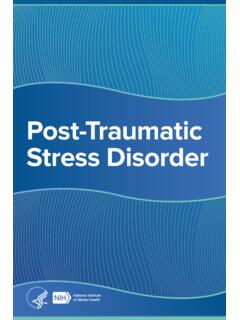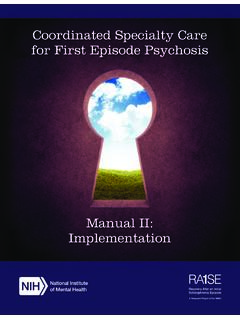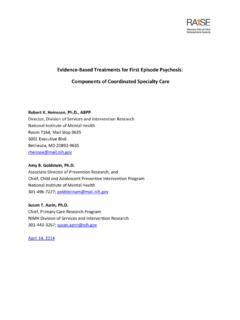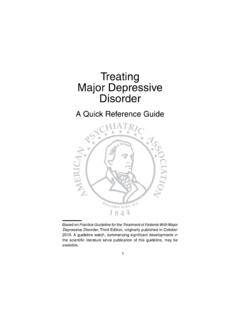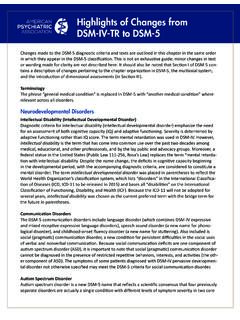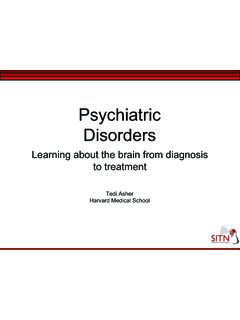Transcription of Bipolar Disorder in Children and Teens
1 National Instituteof Mental HealthDisorderBipolarin Children and TeensDoes your child go through extreme changes in mood and behavior? Does your child get much more excited or much more irritable than other kids? Do you notice that your child goes through cycles of extreme highs and lows more often than other Children ? Do these mood changes affect how your child acts at school or at home?Some Children and Teens with these symptoms may have Bipolar Disorder , a brain Disorder that causes unusual shifts in mood, energy, activity levels, and day-to-day functioning. With treatment, Children and Teens with Bipolar Disorder can get better over time. What is Bipolar Disorder ? Bipolar Disorder is a mental Disorder that causes people to experience noticeable, sometimes extreme, changes in mood and behavior. Sometimes Children with Bipolar Disorder feel very happy or up and are much more energetic and active than usual. This is called a manic episode. Sometimes Children with Bipolar Disorder feel very sad or down and are much less active than usual.
2 This is called a depressive Disorder , which used to be called manic- depressive illness or manic depression, is not the same as the normal ups and downs every child goes through. The mood changes in Bipolar Disorder are more extreme, often unprovoked, and accompanied by changes in sleep, energy level, and the ability to think clearly. Bipolar symptoms can make it hard for young people to perform well in school or to get along with friends and family members. Some Children and Teens with Bipolar Disorder may try to hurt themselves or attempt people are diagnosed with Bipolar Disorder in adolescence or adulthood, but the symptoms can appear earlier in childhood. Bipolar Disorder is often episodic, but it usually lasts a and symptoms of Bipolar Disorder may overlap with symptoms of other disorders that are common in young people, such as attention-deficit/hyperactivity Disorder (ADHD), conduct problems, major depression, and anxiety disorders . Diagnosing Bipolar Disorder can be complicated and requires a careful and thorough evaluation by a trained, experienced mental health professional.
3 With treatment, Children and Teens with Bipolar Disorder can manage their symptoms and lead successful causes Bipolar Disorder ?The exact causes of Bipolar Disorder are unknown, but several factors may contribute to the illness. For example, researchers are beginning to uncover genetic mechanisms that are linked to Bipolar Disorder and other mental disorders . Research shows that people s chance of having Bipolar Disorder is higher if they have a close family member with the illness, which may be because they have the same genetic variations. However, just because one family member has Bipolar Disorder , it does not mean that other members of the family will have it. Many genes are involved in the Disorder , and no single gene causes also suggests that adversity, trauma, and stressful life events may increase the chances of developing Bipolar Disorder in people with a genetic risk of having the research studies have found differences in brain structure and function between people who have Bipolar Disorder and those who do not.
4 Researchers are studying the Disorder to learn more about its causes and effective treatments. What are the symptoms of Bipolar Disorder ?Mood episodes in Bipolar Disorder include intense emotions along with significant changes in sleep habits, activity levels, thoughts, or behaviors. A person with Bipolar Disorder may have manic episodes, depressive episodes, or mixed episodes. A mixed episode has both manic and depressive symptoms. These mood episodes cause symptoms that often last for several days or weeks. During an episode, the symptoms last every day for most of the mood and activity changes are very different from the child s usual behavior and from the behavior of healthy Children and Teens . Children and Teens having a manic episode may: Show intense happiness or silliness for long periods of time. Have a very short temper or seem extremely irritable. Talk fast about a lot of different things. Have trouble sleeping but not feel tired.
5 Have trouble staying focused, and experience racing thoughts. Seem overly interested or involved in pleasurable but risky activities. Do risky or reckless things that show poor and Teens having a depressive episode may: Feel frequent and unprovoked sadness. Show increased irritability, anger, or hostility. Complain a lot about pain, such as stomachaches and headaches. Have a noticeable increase in amount of sleep. Have difficulty concentrating. Feel hopeless and worthless. Have difficulty communicating or maintaining relationships. Eat too much or too little. Have little energy and no interest in activities they usually enjoy. Think about death, or have thoughts of Children and Teens with Bipolar Disorder have other problems?Young people with Bipolar Disorder can have several problems at the same time. These include: Misuse of alcohol and drugs. Young people with Bipolar Disorder are at risk of misusing alcohol or drugs. Attention-deficit/hyperactivity Disorder (ADHD).
6 Children and Teens who have both Bipolar Disorder and ADHD may have trouble staying focused. Anxiety disorders . Children and Teens with Bipolar Disorder also may have an anxiety extreme behaviors go along with mood episodes. During manic episodes, young people with Bipolar Disorder may take extreme risks that they wouldn t usually take or that could cause them harm or injury. During depressive episodes, some young people with Bipolar Disorder may think about running away from home or have thoughts of your child shows signs of suicidal thinking, take these signs seriously and call your child s health care provider. If you think your child is in crisis and needs immediate help, call 911. You also can call the National Suicide Prevention Lifeline (Lifeline) at 1-800-273-TALK (8255), or text the Crisis Text Line (text HELLO to 741741). The deaf and hard of hearing can contact the Lifeline via TTY at 1-800-799-4889. These services are confidential, free, and available 24/7.
7 How is Bipolar Disorder diagnosed?A health care provider will ask questions about your child s mood, sleeping patterns, energy levels, and behavior. There are no blood tests or brain scans that can diagnose Bipolar Disorder . However, the health care provider may use tests to see if something other than Bipolar Disorder is causing your child s symptoms. Sometimes health care providers need to know about medical conditions in the family, such as depression or substance use. Other disorders have symptoms like those of Bipolar Disorder , including ADHD, disruptive mood regulation Disorder , oppositional defiant Disorder , conduct Disorder , and anxiety disorders . It also can be challenging to distinguish Bipolar Disorder from depression that occurs without mania, which is referred to as major depression. A health care provider who specializes in working with Children and Teens can make a careful and complete evaluation of your child s symptoms to provide the right diagnosis.
8 How is Bipolar Disorder treated? Children and Teens can work with their health care provider to develop a treatment plan that will help them manage their symptoms and improve their quality of life. It is important to follow the treatment plan, even when your child is not currently experiencing a mood episode. Steady, dependable treatment works better than treatment that starts and stops. Treatment options include: Medication. Several types of medication can help treat symptoms of Bipolar Disorder . Children respond to medications in different ways, so the right type of medication depends on the child. This means Children may need to try different types of medication to see which one works best for them. Some Children may need more than one type of medication because their symptoms are complex. Children should take the fewest number of medications and the smallest doses possible to help their symptoms. A good way to remember this is start low, go slow.
9 Medications can cause side effects. Always tell your child s health care provider about any problems with side effects. Do not stop giving your child medication without speaking to a health care provider. Stopping medication suddenly can be dangerous and can make Bipolar symptoms worse. Psychosocial Therapy. Different kinds of psychosocial therapy can help Children and their families manage the symptoms of Bipolar Disorder . Therapies that are based on scientific research including cognitive behavioral approaches and family-focused therapy can provide support, education, and guidance to youth and their families. These therapies teach skills that can help people manage Bipolar Disorder , including skills for maintaining routines, enhancing emotion regulation, and improving social interactions. What can Children and Teens expect from treatment?With treatment, Children and Teens with Bipolar Disorder can get better over time. Treatment is more effective when health care providers, parents, and young people work a child s symptoms may change, or disappear and then come back.
10 When this happens, your child s health care provider may recommend changes to the treatment plan. Treatment can take time, but sticking with the treatment plan can help young people manage their symptoms and reduce the likelihood of future child s health care provider may recommend keeping a daily life chart or mood chart to track your child s moods, behaviors, and sleep patterns. This may make it easier to track the illness and see whether treatment is can I help my child or teen?Help begins with the right diagnosis and treatment. Talk to your family health care provider about any symptoms you your child has Bipolar Disorder , here are some basic things you can do: Be patient. Encourage your child to talk, and listen to your child carefully. Pay attention to your child s moods, and be alert to any major changes. Understand triggers, and learn strategies for managing intense emotions and irritability. Help your child have fun. Remember that treatment takes time: sticking with the treatment plan can help your child get better and stay better.

